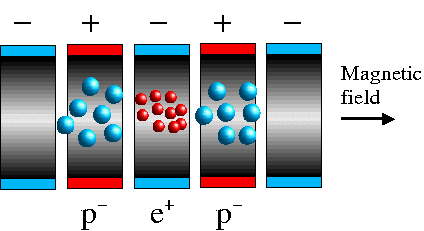| Max-Planck-Institut für Quantenoptik (MPQ) | Laser Spectroscopy Group Home |
|
|
Overview |
Introduction |
Antihydrogen production |
Antihydrogen spectroscopy |
Experiment: 'CW-Lyman-alpha' |
The first hot antihydrogen
Despite the huge difficulties, two experiments succeeded to produce at least high energy antihydrogen (velocity nearly the speed of light). The first 9 antihydrogen atoms were generated at CERN by the PS210 experiment in 1995, and in 1996 the E862 experiment at the Fermilab produced another ~57 antihydrogen atoms. In both cases the approach is roughly the same. One starts with high energy (=velocity) antiprotons, which are then shot onto a target (xenon atoms e.g.). In the collision with an atomic nucleus part of the kinetic energy of the antiproton is converted into many new particles. Also electron-positron pairs are generated. There is a very small probability that the antiproton captures one of the positrons and forms an antihydrogen atom. The antihydrogen atom formed this way still has a very high velocity and cannot be captured for a long and careful study. In the PS210 and E862 experiment the antihydrogen was therefore detected by having annihilation detectors in the path of flight. These two experiments have demonstrated that one can indeed make antihydrogen. The next step is now to demonstrate the production of cold antihydrogen that can be trapped. Only then we can do the highest possible resolution spectroscopy, and hopefully gravitational experiments.
Producing cold antihydrogen
What are the specific difficulties
in producing cold antihydrogen? First of all one has to start with cold
antiprotons and positrons. The predecessor of ATRAP, the TRAP collaboration,
has performed most of the pioneering work in this field. Over a period
of many years G. Gabrielse and his coworkers succeeded in bringing the
energy (momentum) from antiprotons down from several GeV/c to less than
1 meV (equivalent to the temperature of liquid helium: 4K). They were also
able to store them for many months in a 'Penning trap'. See e.g. reference
[1]. The procedure is in short as follows: first the antiprotons are decelerated
in a decelerator ring from a few Gev/c to 100 MeV/c. Then they are shot
though a thin metal foil. Most of the antiprotons annihilate in the foil
(99.99%), but a few escape again with an energy of ~ 3keV. This is slow
enough so that they can be captured in the Penning trap at a temperature
of 4K. Also positrons (or electrons) are loaded in this trap much in the
same way. The positrons/electrons cool down to the surrounding 4K quickly
in such a Penning trap by cyclotron radiation. The lower cyclotron frequency
of the antiprotons make this cooling mechanism less efficient for antiprotons.
However, they are cooled indirectly via Coulomb interaction with the positrons
or electrons.
|
|
 |
Despite the fact that cold positrons and antiprotons have been captured in the same trap, no recombination to antihydrogen has been seen so far. One of the reasons might be that in the nested Penning trap used up to now the particles tend to separate when they cool down. In the axial direction of this trap the positrons and antiprotons are trapped in a double well structure imposed by voltages on many ring electrodes. In the radial direction the particles are trapped by a strong (several Tesla) magnetic field along the axis of the trap (trapping due to the Lorenz force, leading to the cyclotron motion and ExB drift magnetron motion). What a potential valley is for positrons, is a potential hill for antiprotons. Therefore the electrodes and voltages are designed such that positrons and antiprotons each have a potential valley in which they are captured. The trapping region of the antiproton can surround the trap of the positrons. In this case antiprotons can traverse the position trap (which antiprotons see as a potential hill), if they are 'hot' enough (which is still very cold!). Hot antiprotons and positrons can therefore meet and might form antihydrogen. If the antiprotons cool down, they no longer have enough energy to run up the hill, so to speak. As a result the antiprotons and positrons become probably spatially separated over time, and antihydrogen formation is strongly reduced. This picture of the trap dynamics is very much oversimplified but at least points to a possible limitation of the 'nested' Penning trap approach. The truth is that still many questions are open about what actually happens is such a Penning trap. Experiments are underway to test a new approach in a nested Penning trap of 'stimulating' antihydrogen formation with laser light.
Yet another approach has surfaced lately for making antihydrogen:
recombination due to fast switching electric fields. The principle is to
distort the Coulomb potential of the antiproton by adding an electric field.
The electric field results in lowering the potential on one side ('saddle
point') of the antiproton and increasing it on the other side. Positrons
that approach the saddle point can be bound for some time with reduced
energy. If one switches the electric field off during that time, the original
Coulomb potential restores again (increases on the side of the saddle point),
and the positron can be captured if it is of low enough energy. Experiments
have been performed in the group of L.D. Noordam at the AMOLF institute
in Amsterdam demonstrating
electric field induced recombination with Rubidium ions. This method
seems to be very promising for production of antihydrogen as well
References:
[1] G. Gabrielse et al.,
Phys. Rev. Lett. 63, 1360 (1989)
![]()
Kjeld Eikema 20
March 2000